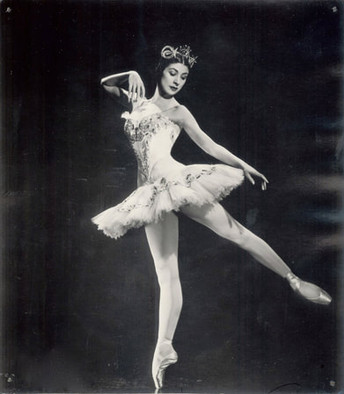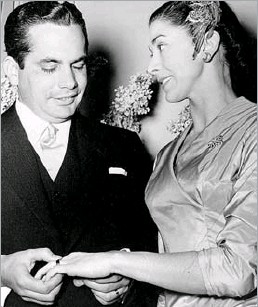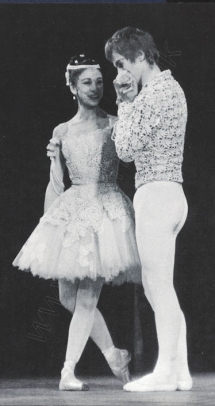Margot Fonteyn - Muses & the Beau Monde
- Lilium
- Mar 3, 2021
- 6 min read

Dame Margaret Evelyn de Arias DBE (née Hookham) born 18 May 1919, known by the stage name Margot Fonteyn, was an English ballerina. She spent her entire career as a dancer with the Royal Ballet (formerly the Sadler's Wells Theatre Company), eventually being appointed prima ballerina assoluta of the company by Queen Elizabeth II.
Beginning ballet lessons at the age of four, she studied in England and China, where her father was transferred for his work. Her training in Shanghai was with George Goncharov, contributing to her continuing interest in Russian ballet.
She returned to London at the age of 14 with plans to pursue a ballet career and was invited to join the Vic-Wells Ballet School by Ninette de Valois. She succeeded Alicia Markova as prima ballerina of the company in 1935. That year, she spent her summer holidays in Paris, where she studied with the exiled Russian ballerinas Olga Preobrajenska, Mathilde Kschessinska, and Lubov Egorova. She returned for further studies with them the following summers. The Vic-Wells choreographer, Sir Frederick Ashton, wrote numerous parts for Fonteyn and her partner, Robert Helpmann, with whom she would go on to dance with from the 1930s to the 1940s. Using Fonteyn's delicate and somewhat feline grace to advantage, "Sir Frederick often cast her as a frail or otherworldly being".
When the company visited the University of Cambridge for a brief professional engagement in 1937, Fonteyn first met Roberto "Tito" Arias, an 18-year-old law student from Panama who would later become her husband. Fonteyn became enamored with Arias after seeing him perform a rumba dance at a party. The pair enjoyed their time together for the next week, but Arias then returned to Panama for the summer holidays. His lack of subsequent communication left Fonteyn despondent.
By 1939 Fonteyn had performed the principal roles in Giselle, Swan Lake and The Sleeping Beauty. Her performance in Swan Lake had been a turning point in her career, convincing critics and audiences that a British ballerina could successfully dance the lead role in a full-length classical Russian ballet. The reviewer Arnold Haskell wrote that never before had Fonteyn's performance been "so regal in manner or half so brilliant", while the writer Tangye Lean commented that she "rose to it with a stability that one had not seen in her before".
During the war, Ashton created roles such as his bleak wartime piece Dante Sonata (1940) and the glittery The Wanderer (1941) for Fonteyn. She also performed notably in Coppélia, imbuing the role with humour. The war years helped her develop stamina and improve her natural talent. In February 1944, she danced the role of the Young Girl in Le Spectre de la Rose and was coached by Russian prima ballerina Tamara Karsavina.
In 1946, the company, now renamed the Sadler's Wells Ballet but would later become The Royal Ballet, moved into the Royal Opera House at Covent Garden where Fonteyn's most frequent partner throughout the next decade would be Michael Somes. One of Fonteyn's first roles was at a command performance of Tchaikovsky'sThe Sleeping Beauty as Aurora with King George, Queen Elizabeth, Queen Mary, both princesses – Elizabeth and Margaret – and Prime Minister Clement Attlee in attendance.
Oliver Messel was tasked with designing the sets and costumes. Initially faced with a costume department severely impacted by post-war rationing, the company had put out a call for every available scrap of silk, velvet or brocade, cutting up and re-purposing old opera costumes, furs and even velvet curtains to create a lavish production. In contrast to most Russian dancers, who traditionally learned roles from previous generations of dancers, Fonteyn had no such living references readily available to teach her the role of Aurora and was obliged to create her own interpretation. The ballet became a signature production for the company and a distinguishing role for Fonteyn, marking her "arrival" as the "brightest crown" of the Sadler's Wells Company.
Her performance in Tchaikovsky’s The Sleeping Beauty became a distinguishing role for both Fonteyn and the company, but she was also well known for the ballets created by Ashton, including Symphonic Variations, Cinderella, Daphnis and Chloe, Ondine and Sylvia.
In 1948, Fonteyn went to Paris to perform as Agathe, a role created for her, in Les Demoiselles de la nuit by the choreographer Roland Petit. The admiration of Petit gave her new confidence and assurance, which showed in her performance in Ashton's Don Juan, but she was injured on the first night, tearing a ligament in her ankle. She was unable to dance for several months, missing the premiere of Ashton's Cinderella.
She recovered sufficiently to dance with Michael Somes in the Christmas presentation of the ballet, and made her mark in the role of Cinderella by challenging the traditional costume for Act I, replacing the usual brown outfit with a stark black dress and a kerchief tied severely over her hair. Observers commented that Fonteyn inserted a new, stronger sense of pathos into the performance.
In 1949, she led the company in a tour of the United States, reprising the role of Aurora, and became an international celebrity. Upon returning to England, Fonteyn danced in George Balanchine's Ballet Imperial, before travelling to Italy with Helpmann and Pamela May as a guest star in The Sleeping Beauty. In the same year, she profiled choreographies of Sir Frederick Ashton, which were no longer in the repertoire of the Sadler's Wells Company, dancing on television with Michael Somes and Harold Turner.
Before and after the Second World War, Fonteyn performed in televised broadcasts of ballet performances in Britain and in the early 1950s appeared on The Ed Sullivan Show, consequently increasing the popularity of dance in the United States.
Plagued by injury, she considered retiring, especially after her most frequent partner of the 1950s, Somes, began to take less challenging roles. On an American tour in 1953, Fonteyn found herself suddenly reacquainted with Roberto "Tito" Arias when he surprised her with a visit to her dressing room after a performance of Sleeping Beauty.
In 1955, she married Roberto Arias and appeared in a live colour production of The Sleeping Beauty aired on NBC.
Shortly before her marriage Fonteyn had been selected to succeed Adeline Genée, as president of the Royal Academy of Dance and though she protested the appointment, the Academy overruled her decision. Adding planning meetings for a new dance syllabus and attending meetings of the Academy, she was honoured as a Dame Commander of the Order of the British Empire in 1956.
Three years later, she and Somes danced for the BBC television adaptation of The Nutcracker. Thanks to her international acclaim and many guest artist requests, the Royal Ballet allowed Fonteyn to become a freelance dancer in 1959.
In 1961, when Fonteyn was considering retirement, Rudolf Nureyev defected from the Kirov Ballet while dancing in Paris. Fonteyn, though reluctant to partner with him because of their 19-year age difference, danced with him in his début with the Royal Ballet in Giselle on 21 February 1962.
The duo immediately became an international sensation, each dancer pushing the other to their best performances. They were most noted for their classical performances in works such as Le Corsaire Pas de Deux, Les Sylphides, La Bayadère, Swan Lake, and Raymonda, in which Nureyev sometimes adapted choreographies specifically to showcase their talents. The pair premièred Ashton's Marguerite and Armand, which had been choreographed specifically for them, and were noted for their performance in the title roles of Sir Kenneth MacMillan's Romeo and Juliet.

The following year, Fonteyn's husband was shot during an assassination attempt and became a quadriplegic, requiring constant care for the remainder of his life. Fonteyn went into semi-retirement in 1972, relinquishing parts in full ballets and limiting herself to only a variety of one-act performances and continuing to dance periodically until the end of the decade. In 1974, she was awarded the Royal Society of Arts' Benjamin Franklin Medal, in recognition of her having built bridges between Britain and the US through her art. In 1979, she was fêted by the Royal Ballet and officially pronounced the prima ballerina assoluta of the company.
She retired to Panama, where she spent her time writing books, raising cattle, and caring for her husband. In 1984 she wrote the introduction for a biography on Anna Pavlova, the famous ballerina who inspired thousands during the first part of the 20th century. Below is an interview where she about Pavlova.
Margot Fonteyn died 21 February 1991, aged 71, exactly 29 years after her premiere with Nureyev in Giselle.
Reading Recommendations & Content Considerations
Margot Fonteyn Autobiography
A Life by
Meredith Daneman Margot Fonteyn
















































































































































































































































































































































